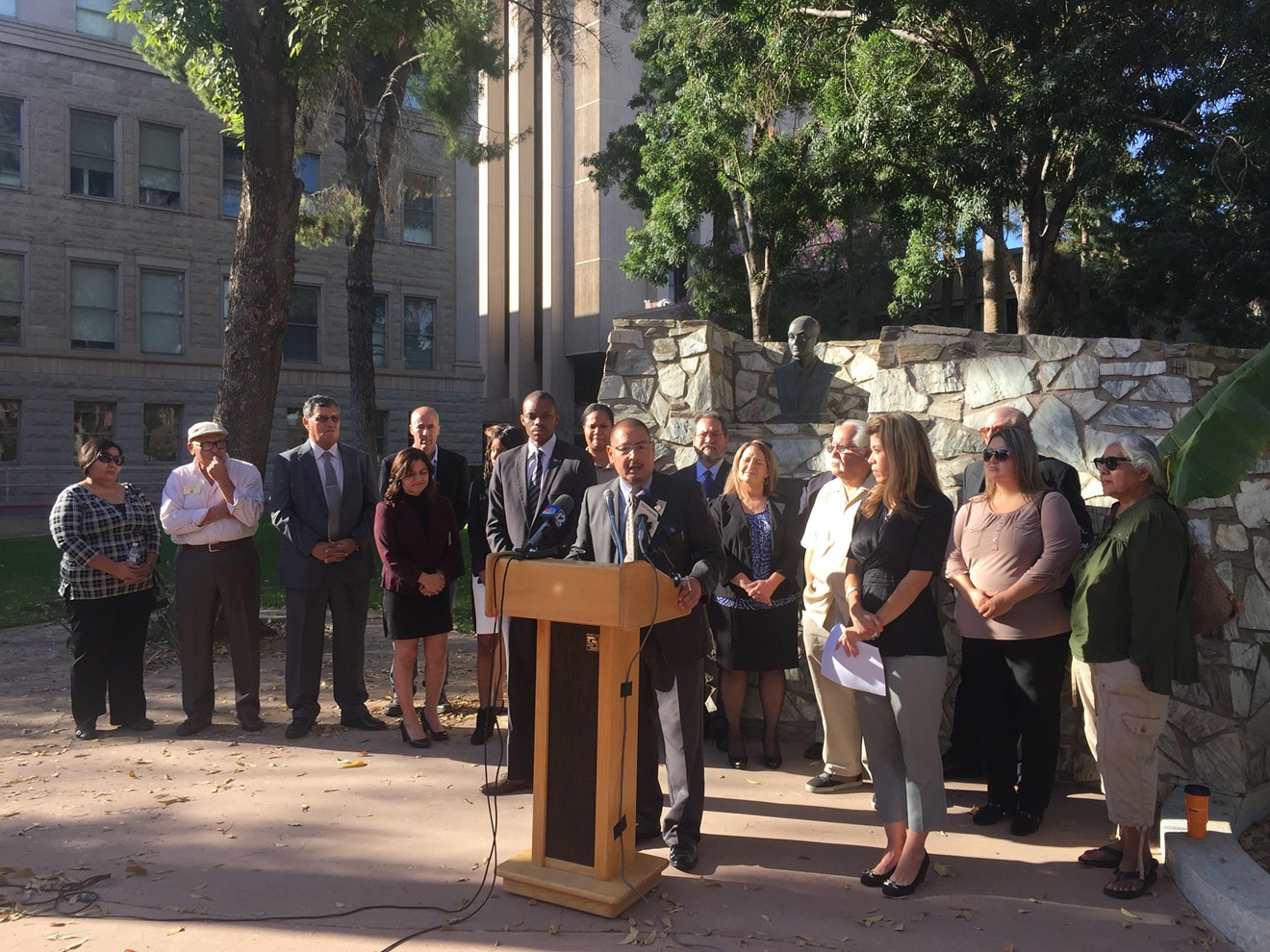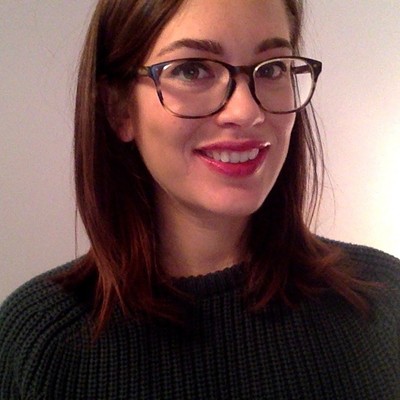Just about everybody seems to like Governor Doug Ducey's idea for a facility that provides substance abuse treatment, life skills classes, job placement assistance, and temporary housing to people who have recently been released from prison.
But it seems like no one wants it in their neighborhood.
Last year, the Ducey administration opened up a re-entry center in North Phoenix, near Interstate 17 and Happy Valley Road. Hundreds of residents from the surrounding community — which is predominantly white, conservative, and middle class — took to the streets in protest.
Now, the governor is looking to potentially move the center to Maricopa County's Durango Criminal Justice Complex in southwest Phoenix. An employment center providing job training and placement services for inmates who will be released soon would also be located at the site, which is perhaps best known as the former home of Tent City.
South Phoenix community leaders are not exactly thrilled.
"Given the history of this community, which has continually been shortchanged, this could almost have been predicted," Arizona House Minority Leader Rebecca Rios, a Democrat who represents South Phoenix, said at a press conference on Monday morning.
She and other residents, business owners, and elected officials all echoed the same point: They support re-entry programs in general, just not in south Phoenix, which has a legacy of environmental racism, a predominantly low-income population that's almost entirely black and Latino, and a historically high crime rate.
"We are not opposed to the cause, pero we say no to the location," said Jose Diaz, the superintendent for the Murphy Elementary School District, which is located a little over a mile from the jail complex.
"Listen to the students who walk the streets," he implored Ducey. "Look into their eyes. You can tell they don't feel safe."
"We already have four jails and one prison. We do not need any other prison or re-entry programs in this area," added Phoenix city councilman Michael Nowakowski, whose district includes southwest Phoenix. "We are not a dumping ground for all the programs that north Phoenix and other parts of the state don't want."
Corina Mejia, a third-generation south Phoenix resident, said that she feels unsafe walking to the corner store or driving around with her windows down because of the high number of drug users and panhandlers in the neighborhood.
"It's bad enough that when you go outside, you see all the trash that's gathered from the homeless people making their camps," she said. "And there's enough drugs in the area already. With these inmates, we don't know what their backgrounds are. How are they screening them? Are they bringing in sex offenders? Are they bringing more drug traffic?"
In fact, last September, the re-entry center stopped housing sex offenders due to neighbors' complaints. That won't change if the center moves to south Phoenix, said Tim Roemer, Ducey's public-safety policy adviser.
"In no way are we treating the two communities differently," he told Phoenix New Times. "We’re treating them the same, in the fact that we’ve made the exact same agreement with both of them."
Roemer said that the state is "far from the point of signing a deal," and added that the Department of Corrections had already offered to meet with community members and hear their concerns.
"We’re open to the idea of other locations," he said. "At this time, we haven’t found a location that is particularly suitable for what we’re looking for in terms of location, capacity, and other factors."
Moving the state-run facility onto property that's owned by Maricopa County will require approval from the county's board of supervisors. In October, chairman Denny Barney signed a nonbinding letter of intent, agreeing to partner with the state to "explore the establishment of a re-entry center and employment center in or around the Durango Criminal Justice Complex or other suitable property."
Roemer was vague about the timeline for finalizing a deal with the county, saying that there were "too many variables at play to say," and that the state "would like to move at a pace that’s comfortable for everyone."
County supervisor Steve Gallardo, a Democrat who represents south Phoenix and opposes moving the re-entry center there, points out that the board only has two more formal meetings scheduled before the end of the year.
It's unclear when the issue will be discussed, he said. (It's not on the agenda for Wednesday night's meeting.)
According to a new law that Ducey signed earlier this year — which was inspired by protests over the re-entry center in north Phoenix — the state will also have to notify all property owners within a two-mile radius, and hold public hearings where they can express their concerns.
Roemer disputed opponents' claims that the governor's office was in a rush to push the proposal through.
"This is a very thorough process," he said. "We had to work with the county to see if this was even a possibility. Now that we know it’s a possibility, we’re going to start going through it a little more and see: What would this look like? What’s the specific location? What’s the capacity? What’s the cost? Where would it go? We’ll have a lot more answers for the community then."
Currently, he said, the ballpark estimate is that the employment center would have a 350-bed capacity and the re-entry center would have a 250-bed capacity. (The re-entry facility in north Phoenix is authorized to hold up to 100 individuals.)
The 350 or so inmates housed at the employment center would be serving out the last 60 days of their sentences, so they'd still be considered regular inmates and wouldn't be able to leave the facility.
Right now, inmate employment centers are located at the Lewis and Perryville prisons in Buckeye and Goodyear, respectively, as well as in Tucson. Moving the two Maricopa County-based employment centers closer to downtown Phoenix would make it easier for potential employers to attend job fairs and provide skills training, Roemer said.
What's more controversial is the plan to move the re-entry center from north Phoenix to south Phoenix. The roughly 250 individuals housed there would be former inmates who have already been released from prison, but have violated the terms of their parole. They would be able to leave the facility during the day, with the expectation that they'd look for jobs and housing.
"It’s controlled movement — they’re not leaving just to leave," Roemer said. "They’ve already served their time, but they’re in danger of going back to prison by violating the terms of their release. This is their last real second chance to get everything together, otherwise they’re going to go back to prison."
"Security would be priority number one," he added.
Why move it from the existing site in north Phoenix?
Roemer says that the Durango complex has plenty of vacant space, which would make it possible to expand both the re-entry center and the employment center, and allow more people to benefit from those programs.
Plus, he said, "It’s an efficiency. We think we can be more efficient out of one central location."
But county supervisor Steve Gallardo is skeptical.
"Do I think they’re feeling political pressure from the [north Phoenix] neighborhood?" he said. "Yes. Is that ultimately their rationale for moving it? Yes. They want to do it before the election year. They want to move it into an area that may not have the resources to fight back like north Phoenix has."
So where should the re-entry center go, since apparently neither north Phoenix nor south Phoenix wants it?
Gallardo has a suggestion: Instead of housing hundreds of recently-released inmates in one location, the state should open multiple smaller re-entry centers that only accommodate 10 to 15 inmates at a time, and spread them out across the county.
"You don’t put a sex offender in a unit with other sex offenders, a drug offender with other drug offenders," he points out. "You don’t cluster them together. I understand it’s probably the cheaper way, but it's not the most effective."
[
{
"name": "Air - MediumRectangle - Inline Content - Mobile Display Size",
"component": "18478561",
"insertPoint": "2",
"requiredCountToDisplay": "2"
},{
"name": "Editor Picks",
"component": "16759093",
"insertPoint": "4",
"requiredCountToDisplay": "1"
},{
"name": "Inline Links",
"component": "17980324",
"insertPoint": "8th",
"startingPoint": 8,
"requiredCountToDisplay": "7",
"maxInsertions": 25
},{
"name": "Air - MediumRectangle - Combo - Inline Content",
"component": "16759092",
"insertPoint": "8th",
"startingPoint": 8,
"requiredCountToDisplay": "7",
"maxInsertions": 25
},{
"name": "Inline Links",
"component": "17980324",
"insertPoint": "8th",
"startingPoint": 12,
"requiredCountToDisplay": "11",
"maxInsertions": 24
},{
"name": "Air - Leaderboard Tower - Combo - Inline Content",
"component": "16759094",
"insertPoint": "8th",
"startingPoint": 12,
"requiredCountToDisplay": "11",
"maxInsertions": 24
}
]













